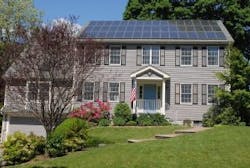Con Edison Plans Virtual Power Plant in New York from 300 Homes… And Other Quick News
Solar panels on a house roof. Source: Wikimedia Commons.
Consolidated Edison plans to create a virtual power plant in New York, formed from the largest residential distributed energy storage program in the U.S.
This summer the utility will invite 300 New York homeowners to participate in the solar plus storage pilot project, which will integrate more than 1.8 MW of solar and some 1.8 MW (4 MWh) of battery storage.
Homeowners can lease SunPower solar systems and for an additional low monthly payment connect Sunverge Energy battery systems, which will provide backup in case of an outage. The solar energy stored in the battery will be available to power certain essential load appliances in the home.
The virtual power plant, created by linking together the homes with solar plus storage, will benefit the grid, supplying power during peak usage periods. Using remote monitoring and control, Con Edison can forecast and optimize performance as well as reduce the need for the utility to rely on fossil fuel power to meet peak demand.
“The integrated solar and storage approach enhances value to the grid by providing a dispatchable renewable power source that Con Edison can control and rely on in real time,” said Matthew Ketschke, Con Edison’s vice president of Distributed Resource Integration. “We are excited to offer customers high performance SunPower systems for no upfront cost, and a cheaper, greener, simpler alternative to a traditional backup generator.”
The pilot program results from New York’s Reforming the Energy Vision (REV) initiative, designed to harness and integrate renewables into the state’s power grid.
“This ambitious program with Con Edison represents a significant milestone in U.S. energy delivery, demonstrating that combining solar and energy storage can result in a stronger, more resilient grid while providing end customers the opportunity to save on electricity bills,” said Howard Wenger, SunPower president, business units.
***
PV solar inverters to maximize microgrids’ solar power, save fossil fuels and cost
A collaboration between solar inverter manufacturer KACO new energy and Nixon Power Services will pursue opportunities to deploy AC microgrids by combining KACO’s PV solar inverters with generators (and other sources of electricity) using controller technology patented by Nixon.
Small, locally controlled microgrids can maximize their use of solar power instead of more expensive carbon fuels. The technology not only saves significant amounts of fossil fuels, but also “reduces the maintenance and life cycle costs associated with prime power generator operations, the heart of any microgrid,” said Nixon Executive Vice President Ken Cockerham,
He added:“If you are electrifying a small remote village in Alaska, Nigeria, or anywhere off grid, reducing diesel fuel consumption that may cost $15/gallon or more, using PV solar derived AC power is a huge benefit. This is especially true when battery storage becomes optional – no longer required – for successful microgrid operations.”
***
Tesla Powerwalls, part of innovative microgrid project, unveiled in Canada
Canadian electric utility Veridian installed two Tesla Powerwalls at its corporate headquarters, part of a microgrid project it launched earlier this year alongside Opus One.
The project will integrate multiple sources of residential clean energy, while maximizing load efficiencies, energy utilization levels and provide backup power in case of grid outages.
“Our goal is to demonstrate and evaluate the benefits of battery storage, renewable energy and electric vehicles for our residential customers, and make progress towards net-zero carbon emission homes and eventually virtual power plants – providing direct benefits and expanded services to our customers,” said Veridian President and CEO Michael Angemeer.
The next phase of the project will see additions of a solar powered carport canopy with electric vehicle charging stations at the company’s corporate headquarters. The project also includes the deployment of two residential microgrids involving two homebuilders – managed by Opus One’s GridOS Microgrid Energy Management System and Veridian’s 24/7 grid operations system.
***
Assessment concludes flow batteries outperform lithium-based at high temperatures
An independent assessment of ViZn’s Z20 and GS200 flow batteries concluded that ViZn’s batteries outperform systems with lithium-based chemistries at high ambient temperatures. This is because ViZn’s energy storage systems perform well at high ambient temperature without any HVAC load.
Black & Veatch’s assessment of ViZn’s energy storage technology also found:
- ViZn’s zinc-iron redox storage technology is designed and manufactured for large scale energy storage applications.
- Key differentiators from other flow battery technologies are: safety and non-flammability of the electrolytes and chemistry, abundance of core raw materials, a 20-year expected system life, an HVAC system is not required to operate at high ambient temperatures, and ViZn’s battery life and warranty are independent of the duty cycle imposed on the system.
The assessment evaluated the design, performance, and manufacturing of ViZn’s Z20 and GS200 flow batteries and assessed ViZn as a company. ViZn says that it is currently building the largest flow battery in North America and is on track to be the largest global producer of flow batteries by the end of the year. The report is available from ViZn upon request.
For more solar and battery storage news, join us on Twitter @MicrogridNews.
